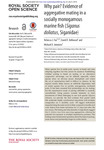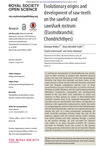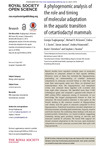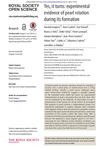Học liệu mở OER: Recent submissions
Now showing items 61-80 of 933
-
Why pair? Evidence of aggregative mating in a socially monogamous marine fish
(2015)Many species live in stable pairs, usually to breed and raise offspring together, but this cannot be assumed. Establishing whether pairing is based on mating, or an alternative cooperative advantage, can be difficult, ... -
Efficient conformational space exploration in ab initioprotein folding simulation
(2015)Ab initio protein folding simulation largely depends on knowledge-based energy functions that are derived from known protein structures using statistical methods. These knowledge-based energy functions provide us with a ... -
A counterview of ‘An investigation of the false discovery rate and the misinterpretation of p-values’ by Colquhoun
(2015)In commenting on the instructive, comprehensive and entertainingly written article by Prof. Colquhoun (hereinafter referred to as ‘the author’), we state unequivocally that we have no truck with its motivation. Indeed, we ... -
The presence of lateral photophores correlates with increased speciation in deep-sea bioluminescent sharks
(2015)The vast majority of species within the lanternshark genus Etmopterusharbour complex luminescent markings on their flanks, whose functional significance has long remained obscure. Recent studies, however, suggest these ... -
Unexpected consequences of a drier world
(2015)The complexity of animal life histories makes it difficult to predict the consequences of climate change on their populations. In this paper, we show, for the first time, that longer summer drought episodes, such as those ... -
To what extent do human-altered landscapes retain population connectivity?
(2015)Understanding how human-altered landscapes affect popula-tion connectivity is valuable for conservation planning. Natural connectivity among wetlands, which is maintained by floods, is disappearing owing to farmland ... -
Relationships within Cladobranchia based on RNA-Seq data
(2015)Cladobranchia (Gastropoda: Nudibranchia) is a diverse (approx. 1000 species) but understudied group of sea slug molluscs. In order to fully comprehend the diversity of nudibranchs and the evolution of character traits ... -
Untitled
(2015)Since the Mid-Holocene, some 5000 years ago, coral reefs in the Pacific Ocean have been vertically constrained by sea level. Contemporary sea-level rise is releasing these constraints, providing accommodation space for ... -
Evolutionary origins and development of saw-teeth on the sawfish and sawshark rostrum
(2015)A well-known characteristic of chondrichthyans (e.g. sharks, rays) is their covering of external skin denticles (placoid scales), but less well understood is the wide morphological diversity that these skin denticles can ... -
Symbiotic bacteria enable olive fly larvae to overcome host defences
(2015)Ripe fruit offer readily available nutrients for many animals, including fruit fly larvae (Diptera: Tephritidae) and their associated rot-inducing bacteria. Yet, during most of their ontogeny, fruit remain chemically ... -
The relationship between pond habitat depth and functional tadpole diversity in an agricultural landscape
(2015)One of the most important goals of biodiversity studies is to identify which characteristics of local habitats act as filters that determine the diversity of functional traits along environmental gradients. In this study, ... -
Models of fertilization kinetics
(2015)Fertilization functions describe how the number of realized fertilizations depends on gamete numbers or density. They provide insight into the fertilization process, and are important components in models on the evolution ... -
What’s the catch?
(2015)The failure of international efforts to manage commercial whaling was exemplified by revelations of large-scale illegal whale catches by the USSR over a 30 year period following World War II. Falsifications of catch data ... -
Incubator-independent cell-culture perfusion platform for continuous long-termmicroelectrode array electrophysiology and time-lapse imaging
(2015)Mostin vitro electrophysiology studies extract information and draw conclusions from representative, temporally limited snapshot experiments. This approach bears the risk of missing decisive moments that may make a difference ... -
A phylogenomic analysis of the role and timing of molecular adaptation in the aquatic transition of cetartiodactyl mammals
(2015)Recent studies have reported multiple cases of molecular adaptation in cetaceans related to their aquatic abilities. However, none of these has included the hippopotamus, precluding an understanding of whether molecular ... -
Phylogenetic tests reject Emery’s rule in the evolution of social parasitism in yellowjackets and hornets
(2015)Social parasites exploit the brood-care behaviour and social structure of one or more host species. Within the social Hymenoptera there are different types of social parasitism. In its extreme form, species of obligate ... -
Tools to tipple
(2015)African apes and humans share a genetic mutation that enables them to effectively metabolize ethanol. However, voluntary ethanol consumption in this evolutionary radiation is documented only in modern humans. Here, we ... -
Proximate causes of the red face of the bald uakari monkey
(2015)In social species, such as primates, facial appearances transmit a variety of social signals. Although it is suggested that the intense red colour of the face of the bald uakari monkey might be an indicator of health, this ... -
Yes, it turns
(2015)Cultured pearls are human creations formed by inserting a nucleus and a small piece of mantle tissue into a living shelled mollusc, usually a pearl oyster. Although many pearl observations intuitively suggest a possible ... -
Iconicity can ground the creation of vocal symbols
(2015)Studies of gestural communication systems find that they originate from spontaneously created iconic gestures. Yet, we know little about how people create vocal communication systems, and many have suggested that vocalizations ...



















